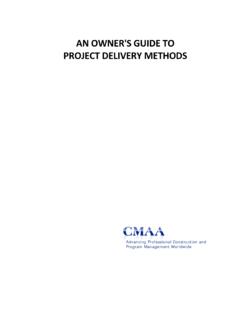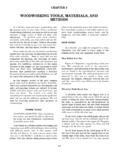Transcription of Labor Force, Employment, and Unemployment, 1929-39 ...
1 Technical Note Labor Force, Employment, and Unemployment, 1929-39 : Estimating methods 1 Estimates of the total Labor force, employment, and unemployment in 1929-39 , which were pre- pared by the bureau of Labor statistics several years ago in order to fill a gap in the official statistics , have been revised recently. These were designed for comparability with the monthly series issued by the bureau of the Census be- ginning in 1940, and together these series provide a continuous set of estimates from 1929 to date. A wide variety of estimates of Labor force and unemployment had previously been prepared by private agencies and individuals. These statistics were of considerable value in informing the public about the gravity of the unemployment situation in the 1930's. In 1945, the BLS developed and made available preliminary estimates of Labor force, employment, and unemployment for the 1929-39 period, com- parable with those then published by the bureau of the Census in its Monthly Report of the Labor Force (MRLF).
2 Subsequently, the Census Bu- reau published revised estimates for 1940-45, incorporating adjustments resulting from an im- provement in interviewing procedure, introduced in July 1945. Corresponding adjustments have now been made in the BLS estimates. The methods used by the BLS in developing its estimates of Labor force, employment, and unem- ployment are discussed in the present article, and a comparison is made with earlier series. i Prepared by Stanley Lebergott, formerly of the bureau 's Division of Employment and Occupational Outlook. Lester Pearlman, Sophia Cooper, Harold Wool, and other staff members cooperated in the development of the estimates. Valuable advice was also received from members of the Budget bureau 's Technical Committee on Labor Supply, Employment, and Unemployment statistics . 50 Total Labor Force To estimate the total Labor force for the years between 1929 and 1940 it was necessary (a) to establish comparable Census bench-mark figures for 1930 and 1940, (b) to interpolate between these bench-mark figures and extend them back to 1929.
3 Estimates of the Labor force in the Census week of 1940 (March 24-30) that are comparable with the current estimates of the MRLF, have recently been published by the bureau of the Estimates for the comparable week of 1930, were computed after adjustment for the change in Labor force definitions between the 1930 and 1940 Cen- suses8 and for the effects of the improvement in interviewing procedure introduced into the MRLF in July The worker rates (i. e., the percent- age of the population in each age-sex group who were in the Labor force) were then computed for the bench-mark periods in 1930 and The Labor force estimates for 1929 and 1931-39, on an April seasonal level, were calculated by (1) interpolating linearly, between the worker rates for 1930 and 1940, and (2) applying the resultant rates to Census estimates of population by age and 1 See: United States bureau of the Census, Labor Force, Employment and Unemployment in the United States, 1040 to 1046, Series P-50, No.
4 2. * The 1030 Census included as "gainful workers" seasonal workers who were not actually at work or looking for work during the Census week, as well as some retired persons and inmates of institutions, who could not have been included in the " Labor force" as defined in the 1040 Census. On the other hand, the 1030 Census excluded young persons who were actually looking for work but had not yet established a gainful occupation. A revision o the 1030 estimates to allow for these and other differences appears in: United States bureau of The Census, Estimates of Labor Force, Employment and Unem- ployment in the United States, 1040 and 1030 (1044). The adjustment for comparability with the revised 1040 Census estimates, as shown in Census release Series P-50, No. 2 (1046) was made by computing the ratios of the revised to unrevised 1040 Census estimates for each sex, age, and employment status group, and applying these ratios to the corresponding groups in 1030.
5 1 Although in the present instance worker rates for age-sex groups were used, calculations might also have been made to allow for the effects of the changing racial composition of the population. Tests indicated, however, that such a refinement would produce no significant change in the final estimate. This content downloaded from on Wed, 1 Oct 2014 08:26:29 AMAll use subject to JSTOR Terms and ConditionsLABOR FORCE- ESTIMATING methods 51 sex for each year. The Labor force estimates for 1929-39 were then adjusted to an annual average basis by use of a seasonal adjustment factor de- rived from the month-to-month movement shown in the MRLF since In table 1, a sharp contrast is apparent between the gradual increase in the Labor force shown for the years 1929-39 and the marked fluctuations reported since 1940 by the bureau of the Census.
6 This reflects in part the unprecedented expansion of the Labor force under wartime pressures and the subsequent contraction. In part, however, it arises because the full extent of variations in the Labor force cannot be determined precisely for those years prior to 1940 when no direct enumera- tions of the Labor force were made. Table 1. - Total Labor force, classified by employment status, 1929-1H7 1 [Annual averages, in thousands] Civilian Labor force Total Armed Employed Year Labor forces Total , ? cul- St 55 Total , cul- _ t- 1029 49,440 260 49,180 47,630 10,450 37,180 1,550 193 0 50,080 260 49,820 45,480 10,340 35,140 4,340 193 1 50,680 260 50,420 42,400 10,290 32,110 8,020 193 2 51,250 250 51,000 38,940 10,170 28,770 193 3 51,840 250 51,590 38,760 28,670 12,830 193 4 52,490 260 52,230 40,890 9,900 30,990 11,340 193 5 53,140 270 52,870 42,260 10,110 32,150 10,610 193 6 53,740 300 53,440 44,410 10,000 34,410 9,030 193 7 54,320 320 54,000 46,300 9,820 36,480 7,700 193 8 54,950 340 54,610 44,220 9,690 34,530 10,390 193 9 55,600 370 55,230 45,750 9,610 9,480 194 0 56,180 540 55,640 47,520 9,540 37,980 8,120 194 1 57,530 1,620 55,910 50,350 9,100 41,250 5,560 194 2 60,380 3,970 56,410 53,750 9,250 44,500 2,660 64,560 9,020 55,540 54,470 9,080 45,390 1,070 194 4 66,040 11.
7 410 54,630 53,960 8,950 45,010 670 194 5 65,290 11,430 53,860 52,820 8,580 44,240 1,040 194 6 60,970 3,450 57,520 55,250 8,320 46,930 2,270 194 7 61,760 1,590 60,170 58,030 8,260 49,770 2,140 > Estimates for the period 1929-39 were prepared by the bureau of Labor statistics . Estimates for the period 1940-47 were adapted from U. S. bureau of the Census, Labor Force Bulletin, Series P-50, No. 2. 1 Total Labor force includes civilian Labor force and the armed forces. The estimates of total Labor force and of the armed forces wore adjusted upward to include about 150,000 members of the armed forces stationed outside the continental United States in March 1940, and who were not enumerated in the Census of that date. The Census bureau reduces its current estimates of the total Labor force by this number in order to maintain comparability with the 1940 Census.
8 Armed Forces Estimates of the net strength of the armed forces prior to 1940 were obtained by the BLS directly from the armed services. The estimates as shown (in table 1) differ slightly from those used in the MRLF beginning in 1940. The Census bureau currently excludes from its estimate of the total Labor force about 150,000 members of the armed forces who were stationed outside of the conti- nental United States in March 1940 and who were therefore not enumerated in the Census of that date. This group is, however, included in the BLS estimates. Employment The estimates of total employment represent the sum of: (1) nonagricultural employees (i. e., wage and salary workers), (2) nonagricultural self- employed, unpaid family workers, and domestic service workers, and (3) agricultural employment. Estimates of nonagricultural employees were based on the movement of the recently revised BLS series of employees in nonagricultural This series was adjusted to the bench-mark totals of nonagricultural employees in 1930 and 1940, as estimated from the Census The estimates of the nonagricultural self- employed were developed for the present series.
9 The general procedure was to develop ratios of self-employed persons per employee separately for each industry group and each year. These were then applied to the corresponding estimates of employees. For those years between 1929 and 1939 when Censuses of Manufactures, Business, and Construction were available, the ratios were computed from the Census data. For inter- censal years, the ratios were computed on the basis of the relationship between (1) the ratios for Census years and (2) the number of employees * Population estimates used were Census estimates of the population for July 1, of each year, as published in Census release Series P-45, No. 5. * A final adjustment was made to include within the total Labor force mem- ben of the armed forces stationed outside of the continental United States and who were, therefore, not in the Census base figures for either 1930 or 1940.
10 There were about 150,000 members of the armed services stationed outside of the continental United States in March 1940 and about 130, 0C0 in 1930. 8 This series was presented in the Monthly Labor Review for December 1947 (p. 647). * Bench mark estimates of nonagricultural employees for April 1930 that were comparable with the current MRLF estimates were prepared in co- operation with the bureau of the Census. These were then adjusted to annual average levels on the basis of monthly employment data of the BLS. Estimates for 1940 were based on the revised Census data published in Census release P-50, No. 2f and on unpublished Census estimates. This content downloaded from on Wed, 1 Oct 2014 08:26:29 AMAll use subject to JSTOR Terms and Conditions52 Labor FORCE- ESTIMATING methods MONTHLY Labor in the appropriate industry group for the same Agricultural employment (including family and hired workers) was estimated on the basis of the movement of the series of the bureau of Agricul- tural Economics, and adjusted to annual average employment in 1930 and 1940, by the use of Census Unemployment Unemployment estimates may be computed (1) by direct enumeration of the unemployed, or (2) by deducting the total of those actually employed from the total available for work (the Labor force).












